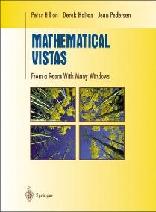'Mathematical reflections and vistas'
 Mathematical reflections:
|
 Mathematical vistas:
|
First the executive summary: read these excellent books, and make sure all your friends and relations and bright pupils (if you are a teacher) or teachers (if a bright pupil) do so too. Mathematical Vistas (MV) is the sequel to the same authors' earlier Mathematical Reflections (MR). Each book is a series of explorations of mathematical topics, informed by a definite idea of what mathematics is, and how it should be taught. The authors append to MR a chapter setting out their answers to these questions, and add some further thoughts in an introduction to MV. In expounding their "basic principle of mathematical instruction", that mathematics should be taught so that students "have a chance of understanding how and why mathematics is done by those who do it successfully", they show a healthy disrespect for some doctrines currently fashionable in certain quarters. In particular they argue against dealing exclusively with applications when presenting a topic. Rather, once a model's application to a class of problems is understood, we should reason - they claim - within the model, dealing with abstract mathematical entities rather than concrete real-world ones.
So much for the theory. In the bulk of these books, the authors put their principles to work by embarking on a series of mathematical excursions, some more applied, some less so. In MR they write about spirals, Fibonacci numbers, paper-folding, infinite sets, and fractals, among other topics. In MV they take some of these subjects further and include chapters on the four-colour theorem, Ramsey theory, Catalan numbers and more. Many of these topics have been singled out for popular presentation before, but MR/MV score by presenting them just as entertainingly but with all the mathematical meat left in. Apart from an outline (in chapter 2 of MV) of the ideas involved in proving Fermat's Last Theorem, the authors restrict themselves to mathematics of which they can present the details as well as an overview to their non-specialist audience. The result is certainly demanding, but it does an excellent job of conveying the excitement of doing real mathematics. Most of the material in MR, and much in MV, could be followed by a really bright 15 year old; and the chapters are fairly independent so that if one chapter gets too hard, the reader can skip to the next one.
MV is not intended to require MR as a prerequisite, but although its chapters are similar in style to those of the earlier book, they are subtly more advanced in flavour. The latter's chapter on Catalan numbers and symmetry, especially, deal in abstractions at a higher level than anything considered in MR, and proceed rather more briskly. For those readers who penetrate this far, however, they are excellent introductions to some very important mathematics.
The authors identify their target readers as "secondary students of mathematics, undergraduate students of mathematics, or adults wishing to update and upgrade their mathematical competence". They have succeeded admirably in finding material for this audience and presenting it excitingly. But they are a little inconsistent as to which technical machinery they introduce carefully and which they allow to pass without comment, which may render the book more inaccessible than it needs to be to some readers. For instance, the standard sigma-notation for sums is quite heavily used, but nowhere introduced. For this reason, such readers will benefit from occasional access to a teacher or other mathematical oracle.
A final note - it is a shame that Springer have packaged such excellent books in the uninviting Undergraduate Texts in Mathematics series, making them both sound and look like the academic textbooks whose uniform they wear. They are nothing of the kind, but the failure of an academic publisher to know quite what to do with more popular texts will undoubtedly prevent many people from
finding these books who would otherwise enjoy them.
|
|